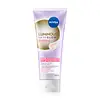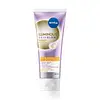What's inside
What's inside
 Key Ingredients
Key Ingredients

No key ingredients
 Benefits
Benefits

 Concerns
Concerns

 Ingredients Side-by-side
Ingredients Side-by-side

Water
Skin ConditioningPropylene Glycol
HumectantPalmitic Acid
EmollientStearic Acid
CleansingGlycerin
HumectantLauric Acid
CleansingPEG-150
HumectantPEG-8
HumectantGlycyrrhiza Glabra Root Extract
BleachingFucus Vesiculosus Extract
EmollientPanax Ginseng Root Extract
EmollientAluminum Chlorohydrate
AstringentCarnitine
CleansingGlyceryl Glucoside
HumectantMalpighia Glabra Fruit Juice
Skin ConditioningCera Alba
EmollientSodium Methyl Cocoyl Taurate
CleansingLactic Acid
BufferingArachidic Acid
CleansingOleic Acid
EmollientCaprylic/Capric Triglyceride
MaskingTrideceth-9
EmulsifyingCitric Acid
BufferingGlucose
HumectantPEG-40 Hydrogenated Castor Oil
EmulsifyingBisabolol
MaskingCaramel
Cosmetic ColorantTrisodium EDTA
Sodium Benzoate
MaskingWater, Propylene Glycol, Palmitic Acid, Stearic Acid, Glycerin, Lauric Acid, PEG-150, PEG-8, Glycyrrhiza Glabra Root Extract, Fucus Vesiculosus Extract, Panax Ginseng Root Extract, Aluminum Chlorohydrate, Carnitine, Glyceryl Glucoside, Malpighia Glabra Fruit Juice, Cera Alba, Sodium Methyl Cocoyl Taurate, Lactic Acid, Arachidic Acid, Oleic Acid, Caprylic/Capric Triglyceride, Trideceth-9, Citric Acid, Glucose, PEG-40 Hydrogenated Castor Oil, Bisabolol, Caramel, Trisodium EDTA, Sodium Benzoate
Water
Skin ConditioningPEG-8
HumectantMyristic Acid
CleansingGlycerin
HumectantStearic Acid
CleansingPotassium Hydroxide
BufferingButylene Glycol
HumectantLauric Acid
CleansingPalmitic Acid
EmollientGlyceryl Stearate Se
EmulsifyingCitrus Sinensis Fruit Extract
AntioxidantSodium Acetylated Hyaluronate
HumectantSodium Hyaluronate
HumectantHydrolyzed Sodium Hyaluronate
Skin ConditioningSodium Hyaluronate Crosspolymer
HumectantSodium Ascorbyl Phosphate
AntioxidantUbiquinone
AntioxidantPolyquaternium-7
Arachidic Acid
CleansingOleic Acid
EmollientCera Alba
EmollientPentylene Glycol
Skin ConditioningSodium Benzoate
MaskingTrisodium EDTA
Parfum
MaskingWater, PEG-8, Myristic Acid, Glycerin, Stearic Acid, Potassium Hydroxide, Butylene Glycol, Lauric Acid, Palmitic Acid, Glyceryl Stearate Se, Citrus Sinensis Fruit Extract, Sodium Acetylated Hyaluronate, Sodium Hyaluronate, Hydrolyzed Sodium Hyaluronate, Sodium Hyaluronate Crosspolymer, Sodium Ascorbyl Phosphate, Ubiquinone, Polyquaternium-7, Arachidic Acid, Oleic Acid, Cera Alba, Pentylene Glycol, Sodium Benzoate, Trisodium EDTA, Parfum
Ingredients Explained
These ingredients are found in both products.
Ingredients higher up in an ingredient list are typically present in a larger amount.
Arachidic Acid is a fatty acid naturally found in peanut oil and cocoa butter. Like other fatty acids, arachidic acid moisturizes the skin.
Synthetically created arachidic acid comes from linoleic acid.
This ingredient may not be safe for Malassezia Folliculitis, or fungal acne.
Learn more about Arachidic AcidCera alba is beeswax, or the wax used by bees to make honeycombs. It is a texture-enhancer and emollient. A study from 2003 found beeswax to be a stronger emollient than ingredients such as petroleum jelly.
As an emollient, beeswax helps hydrate the skin by creating a barrier on top. This barrier traps moisture in.
Emulsifiers help prevent ingredients from separating. This helps create consistent texture.
The structure of beeswax is mainly long-chain alcohols and the esters of fatty acids.
There are three types of beeswax: yellow, white, and absolute. Yellow is pure beeswax taken from the honeycomb. White beeswax is created by filtering or bleaching yellow beeswax. Absolute beeswax is created by treating beeswax with alcohol. Beeswax used in cosmetics are purified.
Beeswax has been used throughout history and even in prehistoric times. Some common uses for beeswax still used today are making candles, as a waterproofing agent, and polish for leather.
Learn more about Cera AlbaGlycerin is already naturally found in your skin. It helps moisturize and protect your skin.
A study from 2016 found glycerin to be more effective as a humectant than AHAs and hyaluronic acid.
As a humectant, it helps the skin stay hydrated by pulling moisture to your skin. The low molecular weight of glycerin allows it to pull moisture into the deeper layers of your skin.
Hydrated skin improves your skin barrier; Your skin barrier helps protect against irritants and bacteria.
Glycerin has also been found to have antimicrobial and antiviral properties. Due to these properties, glycerin is often used in wound and burn treatments.
In cosmetics, glycerin is usually derived from plants such as soybean or palm. However, it can also be sourced from animals, such as tallow or animal fat.
This ingredient is organic, colorless, odorless, and non-toxic.
Glycerin is the name for this ingredient in American English. British English uses Glycerol/Glycerine.
Learn more about GlycerinLauric Acid is a fatty acid or lipid. About half of fatty acids in coconut oil is lauric acid.
This ingredient helps hydrate and sooth skin. As a humectant, it helps trap moisture. It also aids in cleaning and enhancing the texture of products.
Lauric acid may not be Malassezia folliculitis, or fungal acne, safe.
Learn more about Lauric AcidOleic Acid is an Omega-9 fatty acid. It can be found in many plant oils such as avocado and marula oils.
This ingredient is used to enhance the texture of products and as a cleansing agent.
Oleic Acid may not be fungal acne safe.
Learn more about Oleic AcidPalmitic Acid is a fatty acid naturally found in our skin and in many plant and animal sources. In cosmetics, it is usually derived from palm oil. It serves many purposes in skincare, acting as a cleanser, emollient, and emulsifier.
As an emollient, palmitic acid helps soften and smooth the skin by preventing water loss. In cleansers, it helps remove oil and dirt while creating foam.
Its emulsifying properties help stabilize products by keeping water and oil-based ingredients from separating.
This may not be suitable for fungal acne-prone skin, as fatty acids like this can sometimes trigger breakouts in sensitive individuals.
Learn more about Palmitic AcidPEG-8 is a synthetic polymer used as a humectant and solvent.
This ingredient is able to help dissolve active ingredients, including water. This gives it humectant properties.
It is soluble in water. The number '8' stands for the molecular weight of the ingredient.
Learn more about PEG-8Sodium Benzoate is a preservative. It's used in both cosmetic and food products to inhibit the growth of mold and bacteria. It is typically produced synthetically.
Both the US FDA and EU Health Committee have approved the use of sodium benzoate. In the US, levels of 0.1% (of the total product) are allowed.
Sodium benzoate works as a preservative by inhibiting the growth of bacteria inside of cells. It prevents the cell from fermenting a type of sugar using an enzyme called phosphofructokinase.
It is the salt of benzoic acid. Foods containing sodium benzoate include soda, salad dressings, condiments, fruit juices, wines, and snack foods.
Studies for using ascorbic acid and sodium benzoate in cosmetics are lacking, especially in skincare routines with multiple steps.
We always recommend speaking with a professional, such as a dermatologist, if you have any concerns.
Learn more about Sodium BenzoateStearic Acid is a fatty acid. It is an emollient, emulsifier, and texture enhancer.
As an emollient, stearic acid helps soften skin. It aids the skin's protective barrier by preventing water loss. It also provides a gentle cleansing effect without stripping away natural oils.
Stearic acid may also be used to enhance the texture of products. It can add volume and stabilize ingredients such as water and oil. This can help water and oil ingredients from separating.
Sources of stearic acid include animal or vegetable fats/oils such as coconut or shea. It can be naturally found in butter, cocoa butter, shea butter, vegetable fats, and animal tallow.
This ingredient may not be Malassezia folliculitis, or fungal-acne safe.
Learn more about Stearic AcidWe don't have a description for Trisodium EDTA yet.
Water. It's the most common cosmetic ingredient of all. You'll usually see it at the top of ingredient lists, meaning that it makes up the largest part of the product.
So why is it so popular? Water most often acts as a solvent - this means that it helps dissolve other ingredients into the formulation.
You'll also recognize water as that liquid we all need to stay alive. If you see this, drink a glass of water. Stay hydrated!
Learn more about Water